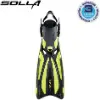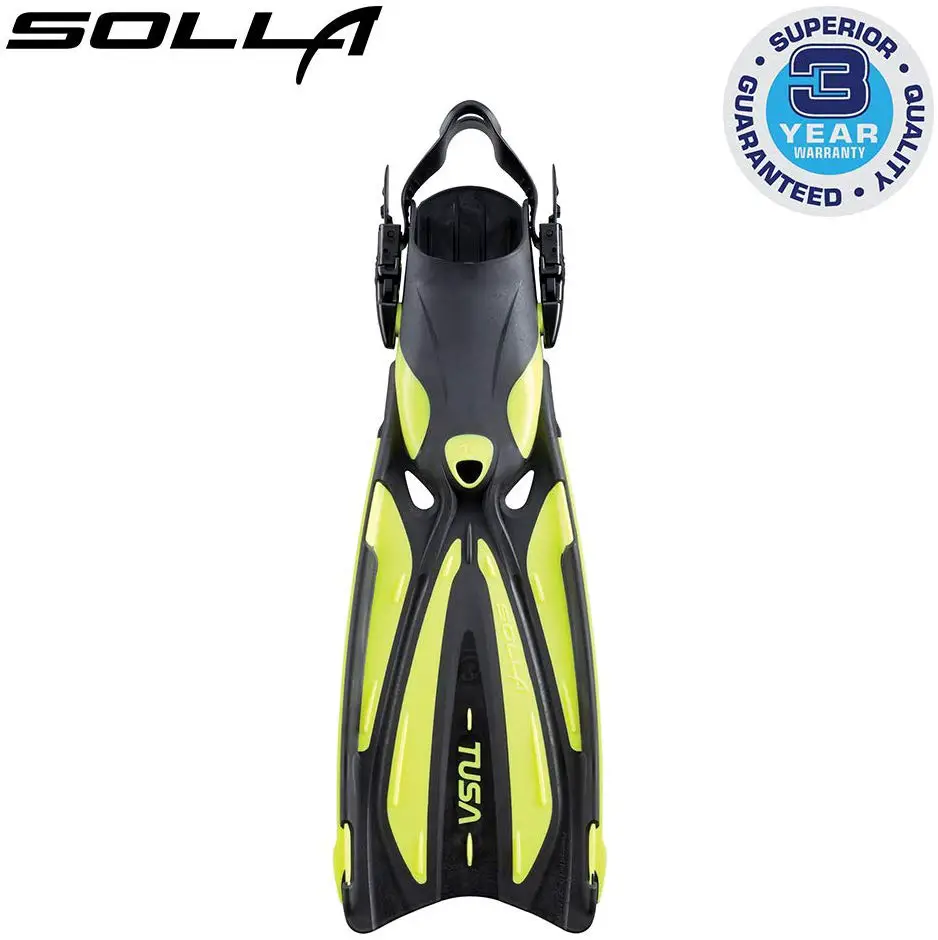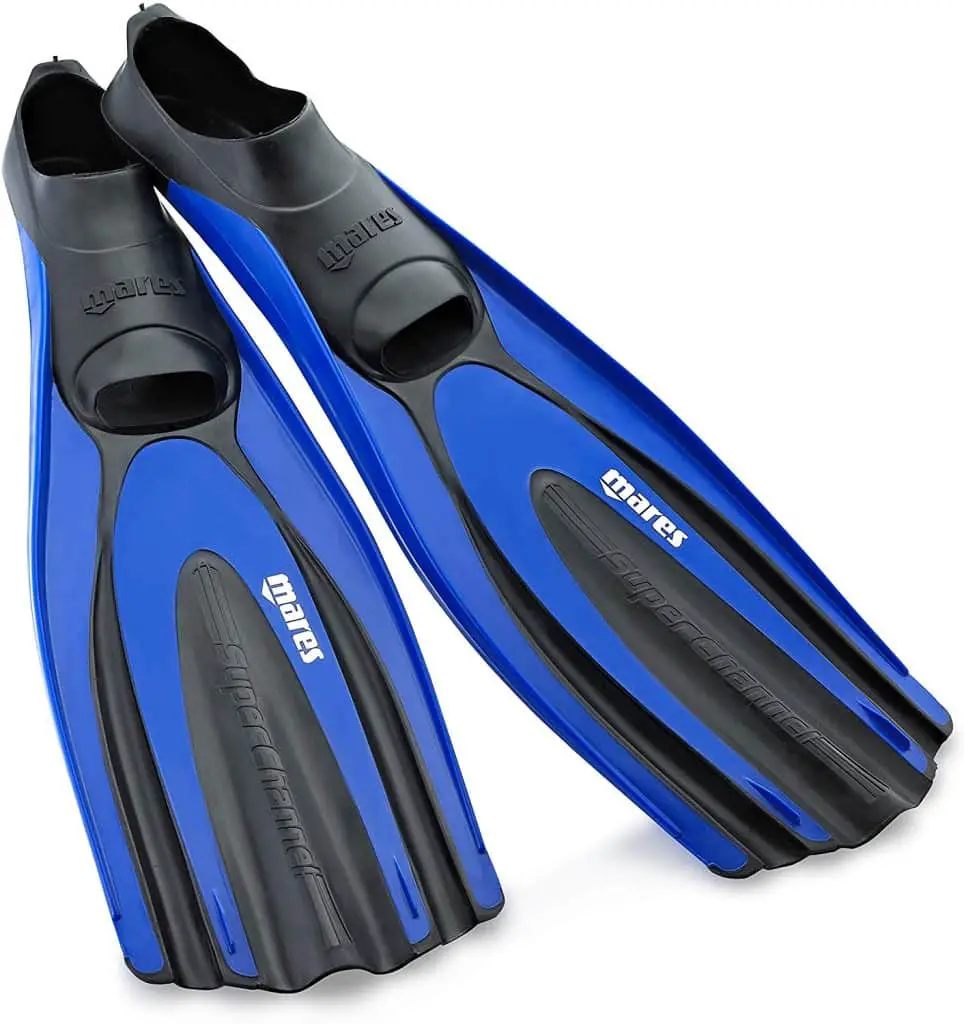Without a doubt, scuba fins are one of the most important tools in diving. Without them, you won’t be able to swim and dive around aquatic life! It improves your buoyancy and allows you to navigate underwater easily. However, if you’re a novice, you may find it challenging to choose the right pair to suit your dive. This post will help you find the best scuba fins for beginners together with our top 5 picks.
| FINS | BRAND | EXPERT RATING | CHECK PRICE |
|---|---|---|---|
 | Cressi Adult Frog Plus Fins |  | |
 | TUSA Solla Open Heel Scuba Fins |  | |
 | SCUBAPRO Jet Sport Adjustable Diving Fin |  | |
 | Mares Italian Full Foot Fins |  | |
 | Deep Blue Gear Latitude 2 Fins |  |
Why use scuba fins
Scuba fins are essential diving gear. It plays a significant role in maintaining your buoyancy, especially during deep dives. It helps you cut through the water and swim without taxing your muscles too much.
Unlike your bare feet, scuba fins have a wider surface and construction made to aid your swimming.
However, it’s not just about using fins. It would be best if you got the right type that suits your skill level and needs. Below, I will discuss a complete guide as well as the best options in the market.
Types of scuba fins
Before you find the best scuba fins for beginners, you first have to choose the right type. Below are the most common types and their purpose.
*Paddle fins
Paddle fins are the most common type of scuba fins. It’s also the most affordable option if you’re on a budget. It’s also easy to kick and typically has a full foot design. This makes paddle fins easy to put on and off as well. Paddle fins are one of the best scuba fins for beginners and those who are into freediving.
Just take note that paddle fins can be very flexible and too stiff. You should check the stiffness to make sure that you’re getting the right configuration for your gear.
*Forced fins
Forced fins are usually used on deep dives as well as divers with powerful kicks. Since it has a larger size, a diver can swim fast, even in deep waters. It’s like the tail of a whale that makes a diver more buoyant underwater.
However, since it’s larger, forced fins are difficult to control, especially for beginner divers. So if you’re not yet very skilled in diving, you must avoid using forced fins in the meantime.
*Split fins
Split fins, on the other hand, look like paddle fins but with a split blade. The division on the blade allows more speed underwater. It also helps divers move swiftly since it uses the kicking force more efficiently.
Also, if you have a frog kicking style, split fins are the best choice for you. The split on the blade reduces the resistance, thus a better propulsion degree.
*Flippable/hinged fins
For those who want a swift transition from water to land, the flippable fins are probably a good choice. It can have a paddle or split blade, but the difference is that there’s a hinge that allows the diver to flip the blade up.
This way, a diver can walk on land with the fins on. This is a new design in the market, and some divers are worried if it can hold up during strong kicks.
Buying Guide for the Best Scuba Fins For Beginners
Before you put your money on the best scuba fins for beginners, make sure that you have read the following points:
-Open or closed heel?
Scuba fins are available in two types: open and closed heel.
Open heeled fins are great if you’re planning to use diving boots. The open space allows you to fit the boot in for extra insulation. This is why open heel fins are perfect for cold water dives, but only if you use a boot in it.
However, the challenge with open heeled fins is finding one with a durable strap. We recommend bringing an extra strap on the boat if you’re diving just in case the current ones give off.
On the other hand, closed heel fins are ideal if you don’t want to bring extra boots. It’s the traditional option that you can slip on and dive immediately. Since it doesn’t have moving parts, it offers peace of mind. It’s also cheaper than open heeled types.
-Proper sizing
Just like buying shoes, you must check the size of the fins you’re planning to purchase. Diving fins should fit your feet like a second skin. It shouldn’t be too loose or too tight. If you feel that the fin is squeezing your feet and there’s so much friction, you need a larger one.
If you’re buying open heeled fins, make sure that you consider how thick your boots are. It would help if you referred to the individual pricing charts of each seller as it varies widely.
-Blade type
Next, always consider the blade type. Vented blades are excellent choices since it increases your propulsion in every kick. It gives extra power, especially during strong currents. Aside from that, the vented type weighs less than non-vented blades.
On the other hand, non-vented blades don’t allow water to pass through. Still, the blades are flexible and allow you to increase your thrusting power. If you have a flutter or frog kick, a non-vented fin might be best for you.
We also want to highlight that split fins are a new blade type. It doesn’t have vent holes, but it uses a slit in the middle of the blade, resulting in two panels. This offers better power, especially if you have joint problems. However, if you have a frog kick, this isn’t the ideal choice for you.
-Blade length
Aside from the blade type, you should also check the length. The blade length will impact the performance of the fins underwater. If you’re diving in an open ocean and deep water conditions, we recommend looking for a longer fin.
If you are diving in overhead environments, you’re better off with shorter fins. Take note that extra-long fins for freediving aren’t suitable for scuba use.
When it comes to your kicking style, we recommend longer fins for flutter kicks and short fins for frog kicks.
-Blade stiffness
There’s no right or wrong fin stiffness. The choice depends on your kicking technique, fitness, diving skill, and strength. If you’re tall and have a strong kick, you need a stiffer blade to channel your strength into better propulsion.
Take note that if you have weaker legs, you should avoid stiff blades as they will easily wear you.
-Extra accessories
Accessories like spare straps, fin bags, markers, and save-a-dive kits all bring more value to your purchase.
-Price point
As a beginner, you should invest in a trusty pair of fins. As much as you can find budget options, adding more dollars would surely give more value. Some fins cost more, but it’s made to last long.
5 Best Scuba Fins for Beginners
OUR #1 CHOICE
[wp-review id=”65″]
RUNNERS-UP
[su_service title=” TUSA Solla Open Heel Scuba Fins ” icon=”icon: star” icon_color=”#2D3092″ size=”32″ class=””][/su_service]

Another pair that we like is the TUSA Solla diving fins. It has an anatomic fin designed with the proprietary Anatomic Fin Strap shaped for better control and flexibility. This allows excellent power transfer and reduction of slippage.
We also like the angled blade design that reduces propulsion loss throughout your kicking cycle. Aside from its ergonomically designed blades, it also comes with an adjustable buckle system to suit you well.
Most of all, these fins are made with TUSA’s proprietary FORCELAST thermoplastic elastomer. It’s positioned on the foot pocket and blade to deliver the best performance underwater. This is paired with reinforced side rails and vents for extra propulsion for strong kickers.
The bonus part here is that the fins are available in different colors like flash yellow, hot pink, ocean green, siesta green, and more. Tusa Solla Open Heel is a good beginner dive fins that you may consider.
[su_row class=””] [su_column size=”1/2″ center=”no” class=””][su_box title=”PROS” style=”noise” box_color=”#115F23″ title_color=”#FFFFFF” radius=”8″ class=””] ✔️Proprietary Anatomic Fin Strap ✔️Vented for strong kickers ✔️Reduces propulsion loss [/su_box][/su_column] [su_column size=”1/2″ center=”no” class=””][su_box title=”CONS” style=”noise” box_color=”#B20010″ title_color=”#FFFFFF” radius=”8″ class=””] . ❌Stiff and not for weak legs . [/su_box][/su_column] [/su_row]
[su_service title=” SCUBAPRO Jet Sport Adjustable Diving Fin ” icon=”icon: star” icon_color=”#2D3092″ size=”32″ class=””][/su_service]

Another open heel fin that we like is this one from SCUBAPRO. It has a three-material blade that provides excellent flex and kicking performance. At the top of the blade, some vents decrease resistance, allowing you to navigate underwater easier.
We also like its big blades that give off a friendly response in the water. Its foot pocket is molded to fit your feet like a glove. This is also equipped with quick-release buckles on the straps, so it’s easy to put on and off.
For your safety, this SCUBAPRO pair has a non-skid pattern so you can walk around without falling. And for those with small feet, this pair is available in extra small sizes.
If you have dolphin or frog kicks, these are the perfect fins for you. You can also use these fins barefoot or with a boot on. These Jet Sport diving fins without a doubt are among the best dive fins for beginners.
[su_row class=””] [su_column size=”1/2″ center=”no” class=””][su_box title=”PROS” style=”noise” box_color=”#115F23″ title_color=”#FFFFFF” radius=”8″ class=””] ✔️Three-material blade ✔️Decreased resistance for better movement ✔️Quick-release buckles [/su_box][/su_column] [su_column size=”1/2″ center=”no” class=””][su_box title=”CONS” style=”noise” box_color=”#B20010″ title_color=”#FFFFFF” radius=”8″ class=””] . ❌The sizing is a little bigger, consider a size down . [/su_box][/su_column] [/su_row]
[su_service title=” Mares Italian Full Foot Fins ” icon=”icon: star” icon_color=”#2D3092″ size=”32″ class=””][/su_service]

It would help if you didn’t miss the Mares Italian Avanti Superchannel Fins for those looking for the best full foot fins. It has three channels that provide the super-channel effect for superior performance. Also, it’s made of thermoplastic and tecralene materials that last long.
Another thing that we love about this is its orthopedic foot pocket with variable thickness to suit your preferred comfort level.
Underwater, these fins will propel water down the fin blade instead of spilling it on the sides. This gives better performance with less effort on the part of the diver.
Aside from that, these fins have upper and lower stabilizers that anchor the blade to maximize the power of your kicks. This reduces leg fatigue and channels the thrust power of your legs efficiently. Just remember that these fins run a little big than most sizing.
[su_row class=””] [su_column size=”1/2″ center=”no” class=””][su_box title=”PROS” style=”noise” box_color=”#115F23″ title_color=”#FFFFFF” radius=”8″ class=””] ✔️Orthopedic foot pocket ✔️Propels water down ✔️Upper and lower stabilizers [/su_box][/su_column] [su_column size=”1/2″ center=”no” class=””][su_box title=”CONS” style=”noise” box_color=”#B20010″ title_color=”#FFFFFF” radius=”8″ class=””] . ❌Runs a little big . [/su_box][/su_column] [/su_row]
[su_service title=” Deep Blue Gear Latitude 2 Fins ” icon=”icon: star” icon_color=”#2D3092″ size=”32″ class=””][/su_service]

Our last recommendation for the best scuba fins for beginners is the full foot Deep Blue Gear Fins. It offers a heel to toe comfort, thanks to its soft rubber foot that prevents chafing. Also, it has medium length blades for casual diving.
This pair of fins is on the lighter side, which suits divers with weaker legs and kicking styles. Its narrow design keeps it intact on your foot while you are underwater.
Aside from that, the Deep Blue Gear fins have a large size variety, which is equivalent to shoe sizing of 5 to 15 on women.
With these fins, you will enjoy maximum propulsion, all thanks to its rubberized blade center. And since it has a full foot design, there’s no need for neoprene socks or boots. Just slip your feet on it, and you’re good to go.
[su_row class=””] [su_column size=”1/2″ center=”no” class=””][su_box title=”PROS” style=”noise” box_color=”#115F23″ title_color=”#FFFFFF” radius=”8″ class=””] ✔️Made for weak kickers ✔️Available in a wide size range ✔️Excellent propulsion [/su_box][/su_column] [su_column size=”1/2″ center=”no” class=””][su_box title=”CONS” style=”noise” box_color=”#B20010″ title_color=”#FFFFFF” radius=”8″ class=””] ❌A bit heavy than most fins under the lightweight category . [/su_box][/su_column] [/su_row]
FAQ
What kind of scuba fin will you be buying, and why for beginners?
You’ll want to make sure your fins are flexible, comfortable, and durable. These three qualities in a fin give it great balance when surfing. It is also important that fins come in a size that can fit any person’s foot – many people have feet that vary in size! Beginner surfers should not get too excited or spend too much money on their first pair of surfboard fins – although it may seem like the best decision at the time!
We would suggest shorter fins. They are better for snorkeling because they’re easier on your leg muscles. With each stroke, you don’t need as much power, and the time spent in the water is shorter when using a shorter fin.
Are full foot scuba fins better?
With fins that go all the way up to your ankles, you’ll be able to move more quickly through the water and need to use much less energy than traditional fins, thus reducing fatigue.
Some people find it easier to swim without having their toes straining for depth. The full foot surfboard type of fin is better for them because they won’t risk getting any bends or twists in their ankles, but also because they will need to use much less energy than with traditional fins– thus reducing fatigue.
It’s not so much an issue if you are a good swimmer and have sturdy feet, but some people find these types of full foot fins offer a lot of comfort and make things easier on your body as you glide along.
Why are scuba fins so long?
The original scuba fins were modeled after the flippers on an airplane. And like flippers, they’re designed to give humans efficiency in water by generating large volumes of thrust and propelling them forward much more readily than if they simply relied on their arms and legs for swimming.
That said, modern scuba fins are now used mainly as a hydrofoil and stabilization device and not so much as propulsion – so they vary in length depending on what you want to do with them.
They also offer many other features that divers may need, such as surface orientation signal lights or pectoral fins for right-left maneuvering, oftentimes referred to as duck feet.
What is the difference between snorkeling fins and scuba fins?
Snorkeling fins and scuba fins both consist of a blade and fin strap. The difference between snorkeling fins and scuba fins is that the blades on snorkeling fins are shorter, more rounded, and less flexible than those used in scuba gear. This difference makes it easier for divers to walk on the seafloor, while snorkelers need to kick harder when they move through the water.
Snorkeling fins and Scuba Fins serve different purposes, and their design reflects this difference. Snorkeling fins are more like “toe-paddles.” They need to be flexible because they work by pushing their foot up and down.
That means that snorkeling fins should not have hard plates – like scuba fins do – on the bottom of them because if they did, then when you pushed your foot up and down, it would put undue pressure on your toes.
Snorkelers don’t typically swim far distances, so some compromise is possible with how much force is generated by the fin. Escapement doesn’t matter for a snorkel diver, so breathing can happen naturally while
Final words
With the best scuba fins for beginners, you can dive with confidence. Unlike fins made for professional divers, those designed for entry levels have features that boost their performance underwater.
Whatever your choice, always check the size, material, and comfort of the fins you’re planning to buy. That way, you can dive and enjoy your underwater adventure.
Did you know that freedivers use different fins from scuba diving fins?! Check out this Buying guide and find the Top 6 Freediving Fins For Beginners.
